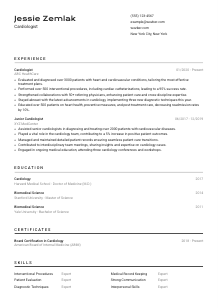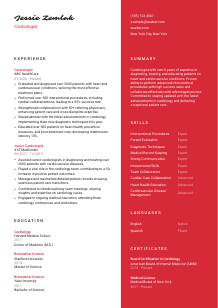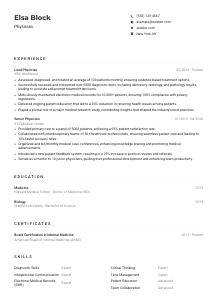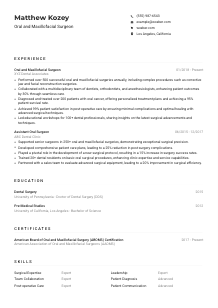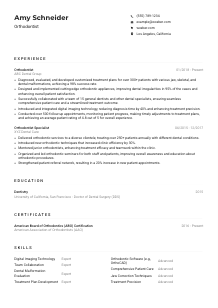Cardiologist Resume Example
Mending hearts, but your resume skipping a beat? Sync it up with this Cardiologist resume example, designed using Wozber free resume builder. Uncover how to rhythmically align your medical prowess with job requirements, setting your career pulse at a healthy pace!
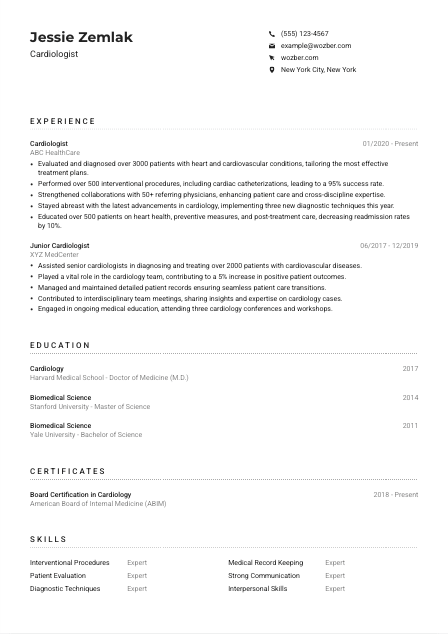
How to write a Cardiologist resume?
Hello, aspiring Cardiologist! In the quest to capture the perfect position, it is essential to understand that your resume is your flagship. It represents your professional journey, highlighting your achievements, expertise, and readiness for the role. Creating a resume tailored specifically for the Cardiologist role you're eyeing, especially one that's ATS-compliant and shaped by the job description, might seem daunting.
Fear not, for by leveraging the power of the Wozber free resume builder, this guide will walk you through tailoring your resume with precision. Embrace this journey to craft a resume that not only meets but exceeds the expectations for a Cardiologist's role.
Personal Details
Diving into the realm of Cardiology, the 'Personal Details' section becomes your first heartbeat on the resume. It's how you introduce yourself in the world of healthcare and Cardiology, making it pivotal to curate this section with both accuracy and alignment to the job particulars. Here are the steps to ensure your personal information resonates with the essence of a Cardiologist:
1. Display Your Name Boldly
Your name is the banner under which all your achievements and qualifications reside. Ensure it's prominently placed with clarity and confidence at the top of your resume, using a font that's professional and accessible.
2. Synchronize with The Job Title
"Cardiologist" should be crisply mentioned beneath your name, mirroring the job title you aspire for. This subtle act of alignment enhances your resume's ATS optimization, guiding the scanner to recognize your suitability at a glance.
3. Ensure Contact Information is Pristine
Your contact details must be pristine and current. A professional email, preferably in the firstname.lastname@email.com format, and a contact number are indispensable. Double-check for accuracy; there's no room for errors here.
4. Localize Your Credentials
Since being located in New York City, New York, is a prerequisition, prominently stating your city and state cements your eligibility and availability. It's a quiet reassurance to your employers about your readiness and logistical ease for the position.
5. Streamline Your Web Presence
For a Cardiologist, a neatly curated LinkedIn profile showcasing your professional network, endorsements, and any articles or publications can be incredibly potent. Ensure it's updated and mirrors the professionalism of your resume.
Takeaway
The 'Personal Details' section might seem foundational, yet it's a crucial pillar that supports the narrative of your professionalism. Crafting it with foresight, aligning it with the job specifics, and ensuring its ATS-compliance sets a solid groundwork for the rest of your resume. Turn this section into an impactful start of your professional testament.





Experience
In a field as intricate and life-impacting as Cardiology, your 'Experience' section is the heart of your resume. It's where you demonstrate the depth of your expertise, the breadth of your knowledge, and your commitment to the profession. Let's carefully stitch this part of your resume to reflect your profound journey in the cardiology landscape.
- Evaluated and diagnosed over 3000 patients with heart and cardiovascular conditions, tailoring the most effective treatment plans.
- Performed over 500 interventional procedures, including cardiac catheterizations, leading to a 95% success rate.
- Strengthened collaborations with 50+ referring physicians, enhancing patient care and cross‑discipline expertise.
- Stayed abreast with the latest advancements in cardiology, implementing three new diagnostic techniques this year.
- Educated over 500 patients on heart health, preventive measures, and post‑treatment care, decreasing readmission rates by 10%.
- Assisted senior cardiologists in diagnosing and treating over 2000 patients with cardiovascular diseases.
- Played a vital role in the cardiology team, contributing to a 5% increase in positive patient outcomes.
- Managed and maintained detailed patient records ensuring seamless patient care transitions.
- Contributed to interdisciplinary team meetings, sharing insights and expertise on cardiology cases.
- Engaged in ongoing medical education, attending three cardiology conferences and workshops.
1. Decipher the Job Dossier
Start by dissecting the job requirements with surgical precision. Highlight elements that resonate with your own experiences. This will help in crafting responses that are not just accurate but are pulse points of your professional journey.
2. Present Your Professional Journey
Arrange your experiences in a chronologically descended order, placing your most recent and relevant role at the forefront. Each entry should clearly state your job title, the name of the institution, and the tenure of your engagement there.
3. Elucidate Your Accomplishments
This step demands you to go beyond mere duties. Share accomplishments that align with the responsibilities like "Evaluated and diagnosed over 3000 patients," painting a vivid picture of your prowess and the scope of your expertise.
4. Quantify Your Impact
Whenever possible, bolster your achievements with numbers. For instance, "Performed over 500 interventional procedures" puts forth a tangible testament to your hands-on experience and success rates.
5. Tailor with Precision
Prune any experience that wanders away from your goal to be seen as the ideal candidate for a Cardiologist role. Keep the narrative focused on your relevant contributions, learnings, and growth in the field of Cardiology.
Takeaway
Your 'Experience' section isn't just a timeline; it's a testament to your competence, dedication, and the tangible impact you've made in Cardiology. As you tailor this section, envision your resume as a mirror, reflecting your professional journey in a way that resonates profoundly with your potential employers. Make each word count, each achievement shine, and let your experience speak volumes of your readiness and suitability for the role you aspire for.
Education
The 'Education' segment of your resume is the cornerstone of your professional foundation. It not only confirms your credentials but also illuminates your dedication to learning and excellence. For a Cardiologist, ensuring this section aligns concisely with the educational prerequisites is crucial. Here's how to sculpt this segment for maximum impact:
1. Identify Key Educational Pillars
Reflect on the job requirements, noting the exact educational qualifications demanded—M.D. or D.O. degree from an accredited medical school. It's paramount that these qualifications are front and center.
2. Lay It Out Clearly
Maintain clarity and simplicity. Structure this section to flow from your most advanced degree backward. Include the degree title, the institution, and your year of completion.
3. Tailor Your Degree Visibility
Since the role explicitly states a need for an M.D. or D.O. with a specialization in Cardiology, ensure these are visibly prioritized. It's more than listing; it's highlighting your direct alignment with the role.
4. Spotlight Relevant Courses
If recent or markedly relevant, spotlight courses or rotations that fine-tuned your understanding of Cardiology. While not necessary for seasoned professionals, for those nearer the start of their careers, it showcases a focused trajectory.
5. Enrich with Non-Degree Education
Don't hold back on presenting additional certifications, workshops, or seminars that have enriched your expertise in Cardiology. Each contributes to portraying a continuum of learning and passion for your field.
Takeaway
The 'Education' section is a silent but powerful advocate of your readiness and suitability for the Cardiologist role. It foregrounds your academic commitment to the field, while also laying groundwork for your practical expertise. With each detail meticulously aligned with the job's educational prerequisites, you present a compelling case of your candidacy. Let your educational journey shine brightly, echoing your dedication and preparedness for the challenging yet rewarding role of a Cardiologist.
Certificates
In the dynamic field of Cardiology, certificates act as badges of ongoing dedication, expertise, and specialization. They are silent yet eloquent testimonies of your commitment to excellence and continuous growth. For a Cardiologist, selectively presenting your certificates can remarkably enhance your resume's standings. Here's how to optimize this section:
1. Align with Job Essentials
The job calls for board certification, or eligibility, in Cardiology. This is non-negotiable. Ensure that any certificates meeting this requirement are listed prominently, citing the governing body and the validity period.
2. Curate with Relevance
Beyond essential certifications, curate additional certifications that demonstrate your widening horizons within Cardiology. Be selective; prioritize those that underscore your specific competencies and knowledge expansions relevant to the role.
3. Date Your Achievements
Timelines matter. Especially in a field that is rapidly advancing, the recency of your certifications can reflect your up-to-date expertise. Be clear about when you were certified – it speaks volumes of your active involvement in your professional growth.
4. Keep the Beat Going
Consider this section as a pulse check on your professional development. Regularly updating your certifications and seeking new avenues of knowledge in Cardiology only strengthens your appeal to potential employers. It shows you're not just keeping pace; you're setting the pace.
Takeaway
Your certificates are more than accolades; they are reflections of your commitment to maintaining and enhancing your expertise in Cardiology. By meticulously aligning and updating this section, you not only signal your qualifications but also demonstrate an unwavering dedication to excellence and growth. They add depth to your professional narrative, complementing your educational and experiential journey. Let each certificate narrate a story of achievement and aspiration within your evolving Cardiology career.
Skills
The 'Skills' segment of your resume is where you present your professional toolkit. It's about showcasing the hard and soft skills that make you an exemplary Cardiologist. Given the nuanced territory of cardiology work, mapping your skills with precision to the job requirements not only showcases your competence but also your potential for superb patient care. Unravel how to fine-tune this section:
1. Extract Key Cardiological Skills
Analyze the job description carefully, picking out both hard and soft skills embedded in the requirements. Skills like 'Diagnostic Techniques' and 'Strong Communication' are gold nuggets waiting to be mirrored from your own arsenal.
2. Converge on Relevant Skills
Pinpoint skills from your repertoire that dovetail with those cited in the job description. For a Cardiologist, emphasizing 'Interventional Procedures,' 'Patient Evaluation,' and 'Team Collaboration' showcases your holistic competencies in the realm of cardiology.
3. Organize and Present with Clarity
With a wealth of skills at your disposal, selecting and organizing them into a coherent list is pivotal. Prioritize skills that sing to the heart of your role as a Cardiologist, ensuring they're ATS-friendly and resonate clearly with the job in hand.
Takeaway
The 'Skills' section of your resume is essentially the diagnostics panel, revealing your adeptness and areas of proficiency. Given the highly technical and empathetic field of Cardiology, ensuring a balanced showcase of your competencies can significantly impact your resume's appeal. Let each skill you list be a testament to your preparedness to excel in the role, with a clear alignment to the specific needs of the position. Present them proudly, knowing they are foundational blocks of your professional identity as a cardiac caregiver.
Languages
In the richly diverse cityscape of New York, the ability to communicate across languages can be a substantial asset, especially in the healthcare field. As a Cardiologist, where communication is paramount, flaunting your multilingual capabilities can enhance your appeal to a diverse patient population. Let's dive into how to polish this section:
1. Match Up with Job Requirements
The job specifies proficiency in English. This should be the centerpiece of your 'Languages' section, marked as 'Native' or 'Fluent,' to resonate with the requirement but also to emphasize your communication skills.
2. Showcase Additional Languages
If you speak other languages, especially those common in New York, list them. This demonstrates your capacity to serve a broader demographic, a valuable trait in the healthcare domain.
3. Rate Your Proficiency Honestly
For each language listed, clearly delineate your level of proficiency. It's essential to provide an accurate reflection of your language skills to set realistic expectations for communication capabilities with patients and colleagues.
4. Evaluate the Scope of the Role
Consider the practical implications of your language skills in the role. In a diverse and cosmopolitan area like New York City, being multilingual could significantly enhance patient care and satisfaction.
5. Recognize Your Global Competence
Your linguistic prowess is a testament to your ability to connect and empathize across cultural boundaries. It's a subtle reminder of your adaptability and sensitivity, key traits for a successful Cardiologist in a multicultural environment.
Takeaway
Languages are your instruments for wider and deeper connections in the medical field. While the primary emphasis is on proficiency in English, showcasing additional linguistic abilities can delineate you as a versatile and patient-centric Cardiologist, especially in a cosmopolitan setting like New York City. These capabilities not only elevate your resume but also underscore your readiness to address the diverse needs of your patient base with empathy and understanding. Let your languages speak volumes of your ability to care beyond borders.
Summary
The 'Summary' section is your resume's opening argument, a compelling prologue that encapsulates your career narrative. For a Cardiologist, crafting a summary that pulses with clarity, competence, and connection to the role is paramount. Here's how to distill your professional journey into a gripping introduction:
1. Capture the Essence of the Role
Begin by internalizing the core responsibilities and requirements of the position. Reflect on how your experiences and achievements directly speak to these aspects. It's about painting a comprehensive picture of your identity as a Cardiologist.
2. Lead with Your Professional Self
Craft an opening line that confidently presents you as a Cardiologist, summarizing years of experience and areas of specialization. This positions you immediately in the reader's mind as a qualified and dedicated practitioner.
3. Zone in on Relevant Skills and Triumphs
Highlight your alignment with the job by showcasing pertinent skills and notable achievements. Remember to weave in metrics where possible, as numbers lend credence and scale to your accomplishments.
4. Keep it Crisp and Memorable
Your summary should be potent and to the point. Aim for a balance of professional gravitas and personal appeal, ensuring it leaves a lasting impression that invites the reader to dive deeper into your professional saga.
Takeaway
The 'Summary' section sets the tone for your resume, serving as a beacon that guides the reader through your professional landscape. In the specialized field of Cardiology, utilizing this space to highlight your alignment with the role's demands and your unique contributions to the field can significantly augment your prospects. Infuse it with your professional essence, making it a powerful prelude to the detailed narrative that follows. Let it resonate with your commitment, expertise, and eagerness to further your journey in the realm of Cardiology.
Launching Your Cardiologist Journey
Congratulations on meticulously crafting your Cardiologist resume! With this guide, you've molded a resume that not only responds to the pulse of the job description but also reflects your distinct professional heartbeat. By leveraging the Wozber free resume builder, including its ATS-friendly resume templates and ATS resume scanner, you've ensured that your resume speaks the language of both technology and human interest, laying out your qualifications in the most appealing light. This is a significant stride on your path to securing your dream Cardiologist role. Remember, each submission is a step closer to your goal.
Stay dedicated, remain patient, and keep your passion for Cardiology at the forefront. The right opportunity is waiting for you to make your mark. Go forth, with confidence and pride in your accomplishments, ready to embark on a new chapter in your remarkable journey through the world of Cardiology.

- Doctor of Medicine (M.D.) or Doctor of Osteopathic Medicine (D.O.) degree from an accredited medical school.
- Board certified or board eligible in Cardiology.
- Valid medical license in the state of practice.
- Minimum of 3 years of clinical experience post-residency/fellowship.
- Strong communication and interpersonal skills to effectively collaborate with patients, families, and interdisciplinary teams.
- Proficient English speaking and listening skills necessary.
- Must be located in New York City, New York.
- Evaluate and diagnose patients with heart and cardiovascular conditions, determining the most effective treatment plan.
- Perform interventional procedures, such as cardiac catheterizations, to diagnose or treat cardiovascular diseases.
- Collaborate with referring physicians, providing expertise in the cardiac care of patients.
- Stay updated with the latest advancements in cardiology, including treatments, medications, and diagnostic techniques.
- Educate patients on heart health, preventive measures, and post-treatment care.






